I recently participated in a FCCNY book club discussion of The Tea Girl of Hummingbird Lane by Lisa See. The book revolves around a Chinese adoption story. The author, Lisa See, is not an adoptee, and her limited knowledge of adoption and adoptee identity development was very apparent throughout the book. At the end of the meeting, the adoptive mothers in the group began discussing book possibilities for future meetings. This prompted me to put together a list of adoption reading for anyone considering an adoption themed book club or wanting more information about adoption.
Book summaries come from their respective Amazon pages.
** indicates adoptee author
+ indicates adoptive parent author
Books that sparked my initial thinking on adoption
I took a transformative class in undergrad called, Transnational Perspectives: Race, Politics, and Empire of Transracial and Transnational Adoption, taught by a Korean adoptee professor. This class turned my life upside down and was what catalyzed my thinking on transracial/transnational adoption on a global and policy level as well as on a personal level. The books in this section were some that were assigned for this class and are the first books I read about adoption that gave me the history and vocabulary to begin discussing the practice in a more nuanced way.

Mothering without a Compass: White Mother’s Love, Black Son’s Courage by Becky W. Thompson+
Sociologist Thompson, whose previous research explored the connections between childhood abuse and eating disorders (A Hunger So Wide and So Deep, 1994), chronicles the emotional rewards of her first year raising Adrian, a nine-year-old African-American boy whose mother has asked Thompson, a white lesbian, to parent him. Thompson eloquently relates the difficulties of bringing up a proud, intelligent and sensitive child in a culture that, she says, does not recognize such qualities in African-American men. She soon finds that her commitment to raising Adrian in a multicultural, progressive environment is trickier than she had imagined. For instance, she encourages the boy to give a classroom presentation about Malcolm X, only to find that the black leader’s arguments about the political efficacy of violence upset the boy and bring up memories of physical abuse at the hands of his stepfather. Furthermore, Adrian’s progressive, private school which caters to a wealthy, liberal clientele forces Thompson to confront her own tenuous middle-class identity, as well as the implications of raising her son in a climate of privilege. . . this memoir will strongly appeal to anyone interested in the complications and pleasures of raising children in a culture of increasingly different and contested “family values.” (Oct.)
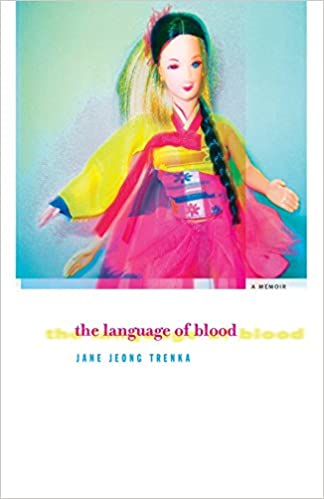
The Language of Blood by Jane Jeong Trenka**
My name is Jeong Kyong-Ah. My ancestry includes landowners, scholars, and government officials. I have six siblings. I am a citizen of the Republic of Korea. I come from a land of pear fields and streams, where people laugh loudly and honor their dead. Halfway around the world, I am someone else.
Jane Jeong Trenka and her sister Carol were adopted by Frederick and Margaret Brauer and raised in the small, homogeneous town of Harlow, Minnesota―a place “where the sky touches the earth in uninterrupted horizon . . . where stoicism is stamped into the bones of each generation.” They were loved as American children without a past.
With inventive and radiant prose that includes real and imagined letters, a fairy tale, a one-act play, crossword puzzles, and child-welfare manuals, Trenka recounts a childhood of insecurity, a battle with a stalker that escalates to a plot for her murder, and an extraordinary trip to Seoul to meet her birth mother and siblings. Lost between two cultures for the majority of her life, it is in Korea that she begins to understand her past and the power of the unspoken language of blood.
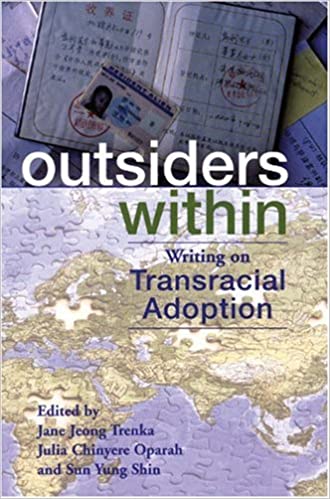
Outsiders Within: Writings on Transracial Adoption edited by Jane Jeong Trenka**, Julie Chinyere Oparah, & Sun Yung Shin
Given Madonna’s recent decision to adopt a child from Malawi, news and entertainment are abuzz with what you’ve observed yourself—in your own family, or the family next door, or passing the neighborhood playground—there’s a boom in transracial adoption. Most coverage focuses on the struggles of good white parents wishing to adopt “unfortunate” children of color. Some touches on the irony of Black babies in the United States being exported to Canada and Europe because of their “unwanted” status here. Some even addresses the trafficking of children (of course, it would—that’s sensational). But few look at
– why babies are available for adoption in the first place
– what happens when they grow up and
– how we come up with solutions that are humane and just
Healthy white infants have become hard to locate and expensive to adopt. So people from around the world turn to interracial and intercountry adoption, often, like Madonna, with the idea that while growing their families, they’re saving children from destitution. But as Outsiders Within reveals, while transracial adoption is a practice traditionally considered benevolent, it often exacts a heavy emotional, cultural, and even economic toll.

Claiming Others: Transracial Adoption and National Belonging by Mark Jerng**
Transracial adoption has recently become a hotly contested subject of contemporary and critical concern, with scholars across the disciplines working to unravel its complex implications. In Claiming Others, Mark C. Jerng traces the practice of adoption to the early nineteenth century, revealing its surprising centrality to American literature, law, and social thought.
Jerng considers how adoption makes us rethink the parent-child bond as central to issues of race and nationality, showing the ways adoption also speaks to broader questions about our history and identity . . . . Imaginative and social practices of transracial adoption have shaped major controversies, Jerng argues, from Native American removal to slavery to cold war expansionism in the twentieth century and the contemporary global market in children. As Claiming Others makes clear, understanding adoption is crucial not just to understanding the history between races in the United States, but also the meaning of emancipation and the role of family in nationhood.

White Mother to a Dark Race: Settler Colonialism, Maternalism, and the Removal of Indiginous Children in the American West and Australia, 1880 – 1940 by Margaret D. Jacobs
In the late nineteenth and early twentieth centuries, indigenous communities in the United States and Australia suffered a common experience at the hands of state authorities: the removal of their children to institutions in the name of assimilating American Indians and protecting Aboriginal people. Although officially characterized as benevolent, these government policies often inflicted great trauma on indigenous families and ultimately served the settler nations’ larger goals of consolidating control over indigenous peoples and their lands.
White Mother to a Dark Race takes the study of indigenous education and acculturation in new directions in its examination of the key roles white women played in these policies of indigenous child-removal. Government officials, missionaries, and reformers justified the removal of indigenous children in particularly gendered ways by focusing on the supposed deficiencies of indigenous mothers, the alleged barbarity of indigenous men, and the lack of a patriarchal nuclear family. Often they deemed white women the most appropriate agents to carry out these child-removal policies. Inspired by the maternalist movement of the era, many white women were eager to serve as surrogate mothers to indigenous children and maneuvered to influence public policy affecting indigenous people. Although some white women developed caring relationships with indigenous children and others became critical of government policies, many became hopelessly ensnared in this insidious colonial policy.

Babies without Borders: Adoption and Migration Across the Americas by Karen Dubinsky+
While international adoptions have risen in the public eye and recent scholarship has covered transnational adoption from Asia to the U.S., adoptions between North America and Latin America have been overshadowed and, in some cases, forgotten. In this nuanced study of adoption, Karen Dubinsky expands the historical record while she considers the political symbolism of children caught up in adoption and migration controversies in Canada, the United States, Cuba, and Guatemala.
Babies without Borders tells the interrelated stories of Cuban children caught in Operation Peter Pan, adopted Black and Native American children who became icons in the Sixties, and Guatemalan children whose “disappearance” today in transnational adoption networks echoes their fate during the country’s brutal civil war. Drawing from archival research as well as from her critical observations as an adoptive parent, Dubinsky moves debates around transnational adoption beyond the current dichotomy—the good of “humanitarian rescue,” against the evil of “imperialist kidnap.” Integrating the personal with the scholarly, Babies without Borders exposes what happens when children bear the weight of adult political conflicts.
Adoptee Memoirs and Personal Narratives

All You Can Ever Know by Nicole Chung**
What does it mean to lose your roots―within your culture, within your family―and what happens when you find them? Nicole Chung was born severely premature, placed for adoption by her Korean parents, and raised by a white family in a sheltered Oregon town. From childhood, she heard the story of her adoption as a comforting, prepackaged myth. She believed that her biological parents had made the ultimate sacrifice in the hope of giving her a better life, that forever feeling slightly out of place was her fate as a transracial adoptee. But as Nicole grew up―facing prejudice her adoptive family couldn’t see, finding her identity as an Asian American and as a writer, becoming ever more curious about where she came from―she wondered if the story she’d been told was the whole truth.
With warmth, candor, and startling insight, Nicole Chung tells of her search for the people who gave her up, which coincided with the birth of her own child. All You Can Ever Know is a profound, moving chronicle of surprising connections and the repercussions of unearthing painful family secrets―vital reading for anyone who has ever struggled to figure out where they belong.
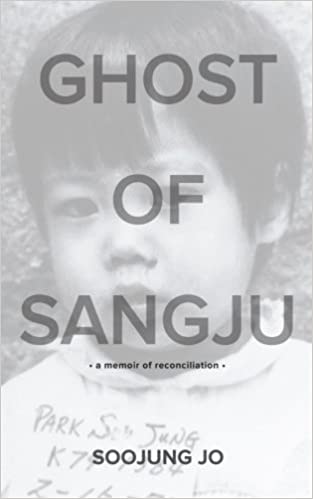
Ghost of Sangju: A Memoir of Reconciliation by Soojung Jo**
“Ghost of Sangju” takes readers through Soojung Jo’s childhood in Kentucky filled with joy, family, friendship—and the loneliness of being marked as an outsider even in her own home. Alternating between humor and heartbreak, she offers a glimpse into a life foreign to most: that of a West Point cadet and her return to South Korea, the country that had once sent her away. Soojung vividly paints a portrait of marriage, parenthood (as both a biological and adoptive mother) and the tumultuous emotions of reuniting, rediscovering, and reestablishing lost familial bonds. “Ghost of Sangju” is a story of one woman’s journey to merge her two selves, and the universal search for self-discovery, identity, and reconciliation.

Fugitive Visions by Jane Jeong Trenka**
Whenever she speaks to a stranger in her native Korea, Jane Jeong Trenka is forced to explain what she is. Japanese? Chinese? The answer-that she was adopted from Korea as a baby and grew up in the United States-is a source of grief, pride, and confusion. Trenka’s award-winning first book, The Language of Blood, told the story of her upbringing in a white family in rural Minnesota. Now, in this searching and provocative memoir, Trenka explores a new question: Can she make an adult life for herself in Korea? Despite numerous setbacks, Trenka resolves to learn the language and ways of her unfamiliar birth country.
In navigating the myriad contradictions and disjunctions that have made up her life, Trenka turns to the lessons from her past-in particular, the concept of dissonance and harmony learned over her years as a musician. In Fugitive Visions, named after a composition by Prokofiev, Trenka has succeeded in braiding the disparate elements of her life into a recognizable and at times heartbreaking whole.
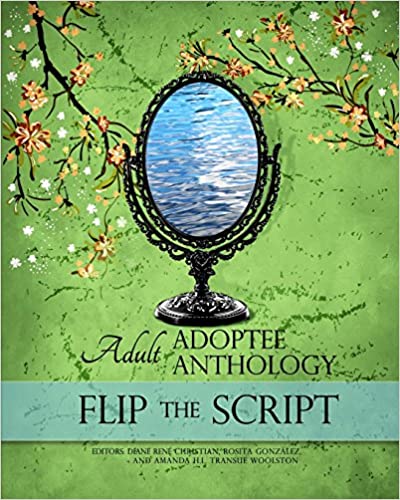
Flip the Script: Lost Daughters Anthology edited by Diane Rene Christian**, Amanda Transue-Woolston**, and Rosita Gonzalez **
‘Flip the Script: Adult Adoptee Anthology’ is a dynamic artistic exploration of adoptee expression and experience. This anthology offers readers a diverse compilation of literature and artistry from a global community of adoptees. From playwrights to poets, filmmakers to photographers, essay writers to lyricists —all have joined together inside these pages to enlighten and educate. We encourage you to Flip through this book and discover what it truly means to Flip the Script!
Fiction
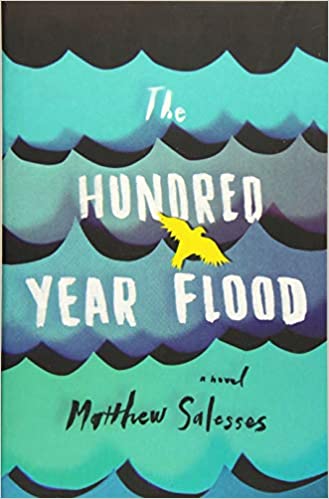
The Hundred Year Flood by Matthew Salases**
In the shadow of a looming flood that comes every one hundred years, Tee tries to convince himself that living in a new place will mean a new identity and a chance to shed the parallels between him and his adopted father. This beautiful and dreamlike story follows Tee, a twenty-two-year-old Korean-American, as he escapes to Prague in the wake of his uncle’s suicide and the aftermath of 9/11. His life intertwines with Pavel, a painter famous for revolution; Katka, his equally alluring wife; and Pavel’s partner—a giant of a man with an American name. As the flood slowly makes its way into the old city, Tee contemplates his own place in life as both mixed and adopted and as an American in a strange land full of heroes, myths, and ghosts. In the tradition of Native Speaker and The Family Fang, the Good Men Project’s Matthew Salesses weaves together the tangled threads of identity, love, growing up, and relationships in his stunning first novel, The Hundred-Year Flood.
Chinese Adoption

One Child: The Story of China’s Most Radical Experiment by Mei Fong
An intimate investigation of the world’s largest experiment in social engineering, revealing how its effects will shape China for decades to come, and what that means for the rest of the world
When Communist Party leaders adopted the one-child policy in 1980, they hoped curbing birth-rates would help lift China’s poorest and increase the country’s global stature. But at what cost? Now, as China closes the book on the policy after more than three decades, it faces a population grown too old and too male, with a vastly diminished supply of young workers.
Mei Fong has spent years documenting the policy’s repercussions on every sector of Chinese society. In One Child, she explores its true human impact, traveling across China to meet the people who live with its consequences. Their stories reveal a dystopian reality: unauthorized second children ignored by the state, only-children supporting aging parents and grandparents on their own, villages teeming with ineligible bachelors, and an ungoverned adoption market stretching across the globe. Fong tackles questions that have major implications for China’s future: whether its “Little Emperor” cohort will make for an entitled or risk-averse generation; how China will manage to support itself when one in every four people is over sixty-five years old; and above all, how much the one-child policy may end up hindering China’s growth.
- (Look for Chapter 8, titled “The Red Thread is Broken” after my blog and features an interview with me.)

China’s Hidden Children: Abandonment, Adoption, and the Human Costs of the One Child Policy by Kay Ann Johnson+
In the thirty-five years since China instituted its One-Child Policy, 120,000 children—mostly girls—have left China through international adoption, including 85,000 to the United States. It’s generally assumed that this diaspora is the result of China’s approach to population control, but there is also the underlying belief that the majority of adoptees are daughters because the One-Child Policy often collides with the traditional preference for a son. While there is some truth to this, it does not tell the full story—a story with deep personal resonance to Kay Ann Johnson, a China scholar and mother to an adopted Chinese daughter.
Johnson spent years talking with the Chinese parents driven to relinquish their daughters during the brutal birth-planning campaigns of the 1990s and early 2000s, and, with China’s Hidden Children, she paints a startlingly different picture. The decision to give up a daughter, she shows, is not a facile one, but one almost always fraught with grief and dictated by fear. Were it not for the constant threat of punishment for breaching the country’s stringent birth-planning policies, most Chinese parents would have raised their daughters despite the cultural preference for sons. With clear understanding and compassion for the families, Johnson describes their desperate efforts to conceal the birth of second or third daughters from the authorities. As the Chinese government cracked down on those caught concealing an out-of-plan child, strategies for surrendering children changed—from arranging adoptions or sending them to live with rural family to secret placement at carefully chosen doorsteps and, finally, abandonment in public places. In the twenty-first century, China’s so-called abandoned children have increasingly become “stolen” children, as declining fertility rates have left the dwindling number of children available for adoption more vulnerable to child trafficking. In addition, government seizures of locally—but illegally—adopted children and children hidden within their birth families mean that even legal adopters have unknowingly adopted children taken from parents and sent to orphanages. The image of the “unwanted daughter” remains commonplace in Western conceptions of China. With China’s Hidden Children, Johnson reveals the complex web of love, secrecy, and pain woven in the coerced decision to give one’s child up for adoption and the profound negative impact China’s birth-planning campaigns have on Chinese families.

Transnational Adoption: A Cultural Economy of Race, Gender, and Kinship by Sara Dorow
Each year, thousands of Chinese children, primarily abandoned infant girls, are adopted by Americans. Yet we know very little about the local and transnational processes that characterize this new migration.
Transnational Adoption is a unique ethnographic study of China/U.S. adoption, the largest contemporary intercountry adoption program. Sara K. Dorow begins by situating the popularity of the China/U.S. adoption process within a broader history of immigration and adoption. She then follows the path of the adoption process: the institutions and bureaucracies in both China and the United States that prepare children and parents for each other; the stories and practices that legitimate them coming together as transnational families; the strains placed upon our common notions of what motherhood means; and ways in which parents then construct the cultural and racial identities of adopted children. Based on rich ethnographic evidence, including interviews with and observation of people on both sides of the Pacific—from orphanages, government officials, and adoption agencies to advocacy groups and adoptive families themselves—this is a fascinating look at the latest chapter in Chinese-American migration

Message from an Unknown Chinese Mother: Stories of Love and Loss by Xinran
Following her internationally bestselling book The Good Women of China, Xinran has written one of the most powerful accounts of the lives of Chinese women. She has gained entrance to the most pained, secret chambers in the hearts of Chinese mothers—students, successful businesswomen, midwives, peasants—who, whether as a consequence of the single-child policy, destructive age-old traditions, or hideous economic necessity, have given up their daughters. Xinran beautifully portrays the “extra-birth guerrillas” who travel the roads and the railways, evading the system, trying to hold on to more than one baby; naïve young girl students who have made life-wrecking mistakes; the “pebble mother” on the banks of the Yangtze River still looking into the depths for her stolen daughter; peasant women rejected by their families because they can’t produce a male heir; and Little Snow, the orphaned baby fostered by Xinran but confiscated by the state.
For parents of adopted Chinese children and for the children themselves, this is an indispensable, powerful, and intensely moving book. Message from an Unknown Chinese Mother is powered by love and by heartbreak and will stay with readers long after they have turned the final page.
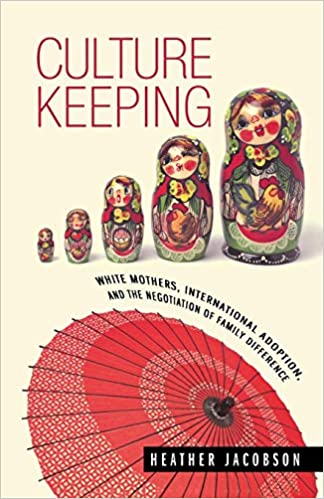
Culture Keeping: White Mothers, International Adoption, and the Negotiation of Family Difference by Heather Jacobson
Since the early 1990s, close to 250,000 children born abroad have been adopted into the United States. Nearly half of these children have come from China or Russia. Culture Keeping: White Mothers, International Adoption, and the Negotiation of Family Difference offers the first comparative analysis of these two popular adoption programs.
Heather Jacobson examines these adoptions by focusing on a relatively new social phenomenon, the practice by international adoptive parents, mothers in particular, of incorporating aspects of their children’s cultures of origin into their families’ lives. “Culture keeping” is now standard in the adoption world, though few adoptive parents, the majority of whom are white and native-born, have experience with the ethnic practices of their children’s homelands prior to adopting.
Jacobson follows white adoptive mothers as they navigate culture keeping: from their motivations, to the pressures and constraints they face, to the content of their actual practices concerning names, food, toys, travel, cultural events, and communities of belonging. Through her interviews, she explores how women think about their children, their families, and themselves as mothers as they labor to construct or resist ethnic identities for their children, who may be perceived as birth children (because they are white) or who may be perceived as adopted (because of racial difference). The choices these women make about culture, Jacobson argues, offer a window into dominant ideas of race and the “American Family,” and into how social differences are conceived and negotiated in the United States.
Academic

Selling Transracial Adoption: Family, Markets, and the Color Line by Elizabeth Raleigh**
While focused on serving children and families, the adoption industry must also generate sufficient revenue to cover an agency’s operating costs. With its fee-for-service model, Elizabeth Raleigh asks, How does private adoption operate as a marketplace? Her eye-opening book, Selling Transracial Adoption, provides a fine-grained analysis of the business decisions in the adoption industry and what it teaches us about notions of kinship and race.
Adoption providers, Raleigh declares, are often tasked with pitching the idea of transracial adoption to their mostly white clientele. But not all children are equally “desirable,” and transracial adoption—a market calculation—is hardly colorblind. Selling Transracial Adoption explicitly focuses on adoption providers andemploys candid interviews with adoption workers, social workers, attorneys, and counselors, as well as observations from adoption conferences and information sessions, toillustrate how agencies institute a racial hierarchy—especially when the supply of young and healthy infants is on the decline. Ultimately, Raleigh discovers that the racialized practices in private adoption serve as a powerful reflection of race in America.

Disrupting Kinship: Transnational Politics of Korean Adoption in the United States by Kimberly McKee**
Since the Korean War began, Western families have adopted more than 200,000 Korean children. Two-thirds of these adoptees found homes in the United States. The majority joined white families and in the process forged a new kind of transnational and transracial kinship.Kimberly D. McKee examines the growth of the neo-colonial, multi-million dollar global industry that shaped these families–a system she identifies as the transnational adoption industrial complex. As she shows, an alliance of the South Korean welfare state, orphanages, adoption agencies, and American immigration laws powered transnational adoption between the two countries. Adoption became a tool to supplement an inadequate social safety net for South Korea’s unwed mothers and low-income families. At the same time, it commodified children, building a market that allowed Americans to create families at the expense of loving, biological ties between Koreans. McKee also looks at how Christian Americanism, South Korean welfare policy, and other facets of adoption interact with and disrupt American perceptions of nation, citizenship, belonging, family, and ethnic identity.

From Orphan to Adoptee: U.S. Empire and Genealogies of Korean Adoption by Soojin Pate**
Since the 1950s, more than 100,000 Korean children have been adopted by predominantly white Americans; they were orphans of the Korean War, or so the story went. But begin the story earlier, as SooJin Pate does, and what has long been viewed as humanitarian rescue reveals itself as an exercise in expanding American empire during the Cold War.
Transnational adoption was virtually nonexistent in Korea until U.S. military intervention in the 1940s. Currently it generates $35 million in revenue—an economic miracle for South Korea and a social and political boon for the United States. Rather than focusing on the families “made whole” by these adoptions, this book identifies U.S. militarism as the condition by which displaced babies became orphans, some of whom were groomed into desirable adoptees, normalized for American audiences, and detached from their past and culture.
Using archival research, film, and literary materials—including the cultural work of adoptees—Pate explores the various ways in which Korean children were employed by the U.S. nation-state to promote the myth of American exceptionalism, to expand U.S. empire during the burgeoning Cold War, and to solidify notions of the American family. In From Orphan to Adoptee we finally see how Korean adoption became the crucible in which technologies of the U.S. empire were invented and honed.

The Primal Wound: Understanding the Adopted Child by Nancy Newton Verrier
The Primal Wound is a book which is revolutionizing the way we think about adoption. In its application of information about pre- and perinatal psychology, attachment, bonding, and loss, it clarifies the effects of separation from the birth mother on adopted children. In addition, it gives those children, whose pain has long been unacknowledged or misunderstood, validation for their feelings, as well as explanations for their behavior. Since its original publication in 1993, The Primal Wound has become a classic in adoption literature and is considered the adoptees’ bible. The insight which is brought to the experiences of abandonment and loss will contribute not only to the healing of adoptees, adoptive families, and birth parents, but will bring understanding and encouragement to anyone who has ever felt abandoned.
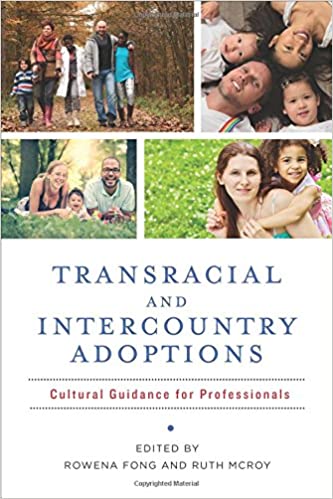
Transracial and Intercountry Adoptions: Cultural Guidance for Professionals edited by Rowena Fong and Ruth McRoy
With essays by well-known adoption practitioners and researchers who source empirical research and practical knowledge, this volume addresses key developmental, cultural, health, and behavioral issues in the transracial and international adoption process and provides recommendations for avoiding fraud and techniques for navigating domestic and foreign adoption laws. The text details the history, policy, and service requirements relating to white, African American, Asian American, Latino and Mexican American, and Native American children and adoptive families. It addresses specific problems faced by adoptive families with children and youth from China, Russia, Ethiopia, India, Korea, and Guatemala, and offers targeted guidance on ethnic identity formation, trauma, mental health treatment, and the challenges of gay or lesbian adoptions.
Asian American Studies

The Making of Asian America by Erika Lee
The Making of Asian America shows how generations of Asian immigrants and their American-born descendants have made and remade Asian American life, from sailors who came on the first trans-Pacific ships in the 1500 to the Japanese Americans incarcerated during World War II. Over the past fifty years, a new Asian America has emerged out of community activism and the arrival of new immigrants and refugees. No longer a “despised minority,” Asian Americans are now held up as America’s “model minorities” in ways that reveal the complicated role that race still plays in the United States.
Published fifty years after the passage of the United States’ Immigration and Nationality Act of 1965, these “powerful Asian American stories…are inspiring, and Lee herself does them justice in a book that is long overdue” (Los Angeles Times). But more than that, The Making of Asian America is an “epic and eye-opening” (Minneapolis Star-Tribune) new way of understanding America itself, its complicated histories of race and immigration, and its place in the world today.

Forever Foreigners or Honorary Whites?: The Asian Ethnic Experience Today by Mia Tuan
What does it mean to be an Asian-American in the United States today? Are Asian-Americans considered “honorary whites” or forever thought of as “foreigners?”
Mia Tuan examines the salience and meaning of ethnicity for later generation Chinese- and Japanese-Americans, and asks how their concepts of ethnicity differ from that of white ethnic Americans. She interviewed 95 middle-class Chinese and Japanese Californians and analyzes the importance of ethnic identities and the concept of becoming a “real” American for both Asian and white ethnics. She asks her subjects about their early memories and experiences with Chinese/Japanese culture; current lifestyle and emerging cultural practices; experiences with racism and discrimination; and attitudes toward current Asian immigration.
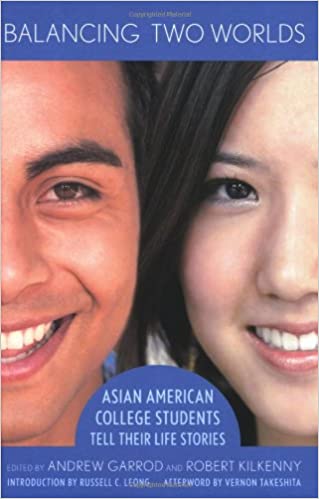
Balancing Two Worlds: Asian American College Students Tell their Life Stories edited by Andrew Garrod and Robert Kilkenny
Balancing Two Worlds highlights themes surrounding the creation of Asian American identity. This book contains fourteen first-person narratives by Asian American college students, most of whom have graduated during the first five years of the twenty-first century. Their engaging accounts detail the students’ very personal struggles with issues of assimilation, gender, religion, sexuality, family conflicts, educational stereotypes, and being labeled the “model minority.” Some of the students relate stories drawn from their childhood and adolescent experiences, while others focus more on their college experiences at Dartmouth.
Anyone who wants to learn about the changing concept of race in America and what it’s like to be a young American of Chinese, Japanese, Korean, Vietnamese, Burmese, or South Asian descent―from educators and college administrators to students and their families―will find Balancing Two Worlds a compelling read and a valuable resource.
Up Next on My List

Multiracial Multicultural Attunement by Kelly Faye Jackson and Gina Miranda Samuels**
What are you? But you don t sound black! Aw, mixed-race babies are so cute!These microaggressions can deeply affect an individual s basic development, identity, sense of security, and belonging. Rather than having the best of both worlds, research suggests that multiracial people and families experience similar or higher rates of racism, bullying, separation, suicide, and divorce than their single-race-identified peers. Multiracial people and families don t face these challenges because they are multiracial, but because dominant constructions of race, rooted in white supremacy, privilege single-race identities. It is this foundation of monocentrism that perpetuates the continued pathologizing and exotifying of people and families of mixed-race heritage. Furthermore, pervasive but misguided claims of colorblindness often distort the salience of race and racism in our society for all people of color. This reinforces and enables the kind of racism and discrimination that many multiracial families and people experience, often leaving them to battle their oppression and discrimination alone. In this book, Jackson and Samuels draw from their own research and direct practice with multiracial individuals and families, and also a rich interdisciplinary science and theory base, to share their model of multiracial cultural attunement. Core to this model are the four foundational principles of critical multiraciality, multidimensionality and intersectionality, social constructivism, and social justice. Throughout, the authors demonstrate how to collaboratively nurture clients emerging identities, identify struggles and opportunities, and deeply engage clients strengths and resiliencies. Readers are challenged to embrace this model as a guide to go beyond the comfort zone of their own racialized experiences to disrupt the stigma and systems of racism and monoracism that can inhibit the well-being of multiracial people and families. With case studies, skill-building resources, tool kits, and interactive exercises, this book can help you leverage the strengths and resilience of multiracial people and families and pave the way to your own personal growth and professional responsibility to enact socially just practices.

Here’s another good one — Our Son, a Stranger https://www.mqup.ca/our-son-a-stranger-products-9780773524002.php
LikeLike
Thanks for the suggestion!
LikeLike
Thank you for sharing all of these titles!
LikeLike
You’re welcome! I hope that you’re able to get your hands on some of these books!
LikeLike
Pingback: Love is NOT all you need | Red Thread Broken·